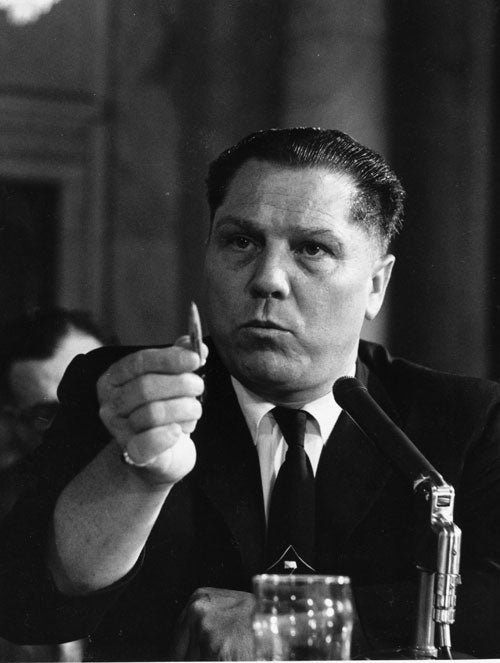The Teamsters, a trade union like no other
In its dispute with BA, Unite has consulted the infamous US transport workers' outfit. Talk about playing with the big boys

If Unite wanted a high-profile foreign ally in its battle with British Airways, it could have done no better than the Teamsters. America's largest transport union may no longer be as famous as when Jimmy Hoffa was at its helm half a century ago. But in American organised labour, it is still a force to be reckoned with, boasting 1.4 million members and a name that is the stuff of myth.
From its foundation in 1903 – the title relates to the teams of horses that once provided the muscle for the movement of goods in America – the International Brotherhood of Teamsters has played a huge part in union history in the US. Its power lay, then as now, in its ability to paralyse commercial transport; as one of its chieftains once put it, to "jam the gears of American business".
The event that truly sealed that power was the Minneapolis Teamsters' strike of 1934. A strike by coal truckers in one of the main transport hubs of the Midwest turned violent: riots took place; martial law was declared by the authorities and two people were killed. But the Teamsters won, breaking the resistance of the anti-union Citizens' Alliance organisation. That success, in the depths of the Great Depression, turned the Teamsters into a truly national union, and launched modern-style union organising in the US.
But almost from the start, the Teamsters were plagued with corruption. That ability to jam the gears of business made them an obvious target for infiltration by organised crime, to put the squeeze on employers. Some high-ranking Teamster officials, especially in the industrial north east, were de facto mobsters.
The links were never more obvious than during the reign of Jimmy Riddle Hoffa, president of the Teamsters from 1958 to 1971. His biggest achievement was to obtain a single collective bargaining agreement for every truck driver in America, in 1964. Long before that, however, Hoffa was attracting the close attentions of the McClellan Committee on Capitol Hill, set up to examine the links between the union movement and organised crime – and of the committee's chief counsel, one Robert F Kennedy.
As Attorney General in his brother's administration RFK carried on his pursuit of Hoffa, finally securing his conviction in 1964 for attempted bribery of a juror in an earlier trial. Hoffa finally began his eight-year sentence in 1967, before being released in 1971. He wanted to regain the Teamsters' presidency. However, the mob, delighted with his pliant replacement Bob Fitzsimmons, disagreed.
In 1975 matters came to a head. Hoffa had agreed to meet two mafia bosses, one of whom – Anthony Provenzano – was also a Teamster leader in New Jersey, at the Red Fox restaurant in the northern Detroit suburbs. They failed to keep the appointment, set for the afternoon of 30 July; instead Hoffa left, or was taken by someone from, the parking lot, never to be seen again. Despite various tip-offs over the years, his body has not been found. In 1982, he was declared legally dead, presumed victim of a mob rub-out. Ten years later the mystery inspired the film Hoffa, with Jack Nicholson in the title role.
In the event, Jimmy Hoffa's death roughly coincided with the start of the long modern decline of America's union movement. Since the 1970s, both the number of major strikes and the total union membership have fallen. By 2005, organised labour represented less than
10 per cent of private-sector workers, down from a high of almost 30 per cent in the late Fifties, though the proportion was greater in the public sector.
The reasons for the decline are familiar: increased global competition, a relentless quest for higher productivity, the trend towards out-sourcing and the offshoring of labour, and the advance of political conservatism. The unions have been powerless to prevent wage stagnation, and the ever widening disparity between America's rich and poor. Since 1972, the median wage here, after inflation, has fallen by 13 per cent. The latest recession hasn't helped either, nor have splits in the union movement's governing structure.
And the Teamsters haven't escaped the trend, although membership recently began to pick up. Even so, under James P Hoffa, son of Jimmy and the Teamsters' president since 1999, it remains arguably the most powerful single union in North America, strongly represented in the construction, port and, of course, transport sectors – as well as the aviation industry, where the Teamsters' Airline Division has 40,000 members. Back in 1997, the Teamsters staged a successful two-week strike against UPS; the contacts with Unite suggest that a British Airways strike could gain a significant international dimension.
But its political clout is limited, despite the large sums the Teamsters have contributed to Democrats over the years. Payback remains elusive. President Obama and his party may control Congress and the White House, but they have, thus far, signally failed to pass the Employee Free Choice Act, that would have made it easier to set up a union as an exclusive bargaining entity with a company. That measure, like much else, is bogged down in Congress, where corporate and lobbying money counts more than anything even the Teamsters can deliver.
Subscribe to Independent Premium to bookmark this article
Want to bookmark your favourite articles and stories to read or reference later? Start your Independent Premium subscription today.

Join our commenting forum
Join thought-provoking conversations, follow other Independent readers and see their replies